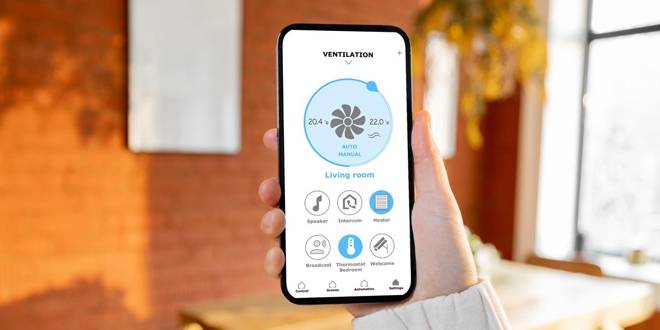
In today’s fast-paced world, the integration of smart technology into home and business environments is not just a trend; it’s a step towards enhanced efficiency, comfort, and control. For residents and business owners in Shingle Springs, CA, and surrounding areas, integrating smart technology with HVAC systems can revolutionize the way you manage indoor climates.
Understanding Smart Home Integration with HVAC
Smart home integration involves connecting your HVAC system to a smart home network. This network typically includes a central hub controlled via a smartphone app or voice commands. The integration allows for automated adjustments of heating and cooling settings based on predefined preferences, external weather conditions, and even your daily schedule.
Key Benefits of Smart HVAC Integration
The integration of smart technology with your HVAC system brings a host of advantages that can transform your living or working environment. Here are some key benefits that homeowners and business owners in Shingle Springs, CA, and surrounding areas can expect:
- Energy Efficiency: Smart HVAC systems can significantly reduce energy consumption. By learning your schedule and adjusting temperatures accordingly, these systems ensure that you’re not heating or cooling an empty space, leading to lower utility bills.
- Enhanced Comfort: Imagine your home or office being at the perfect temperature when you arrive. Smart systems can be programmed to start heating or cooling based on your proximity to the location, ensuring optimal comfort at all times.
- Remote Control and Monitoring: Whether you’re in another room or away from your property, you can monitor and adjust your HVAC settings remotely. This feature is particularly beneficial for business owners who need to manage multiple properties.
- Maintenance Alerts: Smart HVAC systems can detect and alert you about maintenance needs or potential issues before they escalate into costly repairs.
- Customization and Flexibility: Each room can have its temperature controlled independently, catering to the specific preferences of different individuals in a household or different areas in a business.
Implementing Smart HVAC Integration in Shingle Springs, CA
Adopting smart HVAC technology in your home or business requires careful planning and execution. Here’s how residents and business owners in Shingle Springs, CA, can effectively implement smart HVAC integration:
- Choose the Right System: Select a system compatible with your existing HVAC setup. Brands like Goodman, Daikin, Trane, GE, and Bryan offer smart-compatible models.
- Professional Installation: For residents in Shingle Springs and nearby areas, relying on experienced technicians like those from Good Guys Heating and Cooling ensures that your smart HVAC system is installed correctly and integrated seamlessly with your smart home network.
- Customize Your Settings: Work with your HVAC provider to set up the system according to your lifestyle. This might include setting different temperatures for different times of the day or automating the system based on weather forecasts.
- Regular Maintenance: To keep your smart HVAC system running efficiently, schedule regular maintenance. Service Club Membership programs, like the one offered by Good Guys Heating and Cooling, can provide regular check-ups and maintenance reminders.
Smart home integration with HVAC systems is more than a luxury; it’s a practical, energy-efficient solution tailored for modern living and working. For the residents and business owners of Shingle Springs, CA, and surrounding areas, this integration not only promises enhanced comfort and convenience but also contributes to a sustainable, cost-effective lifestyle. Embrace the future of HVAC technology and experience the transformation in your daily life.
Integration with Broader Smart Home Ecosystems
Smart HVAC systems are just one piece of the broader smart home platform. Integration with other smart home gadgets like thermostats, lighting, and security systems creates a cohesive, interconnected home environment. For instance, smart thermostats can communicate with your HVAC system to adjust temperatures based on your daily routines or even the number of people in a room. Similarly, integration with smart lighting and security systems can lead to an automated home environment where climate control, smart bulbs, and smart door locks work in tandem, offering a seamless, intuitive living experience.
Technical Aspects of Integration
The technical side of integrating smart HVAC systems into your home involves several key components. Firstly, a central hub or controller, often a smart thermostat, acts as the brain of the system. This hub communicates with your HVAC system using wireless technologies such as Wi-Fi, Zigbee, or Z-Wave. The integration also requires compatible HVAC systems that can receive and interpret signals from the hub. Additionally, the smart home system may involve sensors placed throughout the home to monitor conditions like temperature, humidity, and occupancy, providing data back to the central hub for optimal climate control.
Future Trends in Smart Home Integration
The future of smart home integration is poised for exciting developments. We can expect to see more AI-driven systems that learn from user behavior and adjust settings for maximum comfort and efficiency. The integration of renewable energy sources, like solar power, with HVAC systems is another area of growth, promoting sustainability. Additionally, the rise of the Internet of Things (IoT) will likely lead to more interconnected devices, offering even more personalized and efficient home automation systems.
User Experience and Interface Design
The user experience and interface design of smart HVAC systems are crucial for ensuring ease of use and accessibility. Modern systems feature intuitive apps that allow users to control their HVAC settings from anywhere. These apps often provide a user-friendly interface with features like scheduling, real-time temperature adjustments, and maintenance notifications. Voice control integration with assistants like Alexa, Google Nest, or Google Home Assistant is also becoming standard, allowing for hands-free operation and enhancing the overall user experience.
Energy Efficiency and Sustainability
Energy efficiency and sustainability are at the heart of smart HVAC integration. These systems are designed to minimize energy usage while maintaining comfort. By optimizing heating and cooling schedules and reducing energy waste, smart HVAC systems play a significant role in reducing a household’s carbon footprint. Furthermore, as these systems become more sophisticated, they are increasingly capable of integrating with green technologies, such as geothermal heating or cooling systems, further enhancing their sustainability profile. This not only benefits the environment but also translates to significant cost savings for homeowners and businesses over time.
FAQ: Smart Home Integration with HVAC Systems
What is smart home integration with HVAC systems?
Smart home integration with HVAC involves connecting your heating, ventilation, and air conditioning system to a smart home network. This allows for automated control, remote monitoring, and enhanced efficiency through a central hub or app.
How does smart HVAC integration improve energy efficiency?
Smart HVAC systems optimize energy use by adjusting temperatures based on your schedule, presence, and even weather conditions. This reduces unnecessary heating or cooling, leading to lower energy bills and a reduced carbon footprint.
Can I control my HVAC system remotely with smart integration?
Yes, smart integration allows you to control your HVAC system remotely using a smartphone app or web interface. You can adjust settings, monitor system performance, and receive alerts no matter where you are.
Are smart HVAC systems difficult to install?
The complexity of installation varies depending on your existing HVAC system and the smart device you choose. Professional installation by a qualified technician, like those from Good Guys Heating and Cooling, is recommended for seamless integration.
Will smart HVAC integration work with all types of HVAC systems?
Most modern HVAC systems are compatible with smart home technology. However, it’s important to check the compatibility of your existing system with the smart devices you plan to use.
Can I integrate renewable energy sources with my smart HVAC system?
Yes, many smart HVAC systems can be integrated with renewable energy sources like solar panels, enhancing sustainability and energy efficiency.
How does smart HVAC integration contribute to a home’s overall smart ecosystem?
Smart HVAC integration allows your heating and cooling system to work in conjunction with other smart home devices, like smart lights and security systems, creating a more efficient, responsive, and automated home environment.
What kind of maintenance does a smart HVAC system require?
Like traditional HVAC systems, smart HVAC systems require regular maintenance. Smart features can provide maintenance reminders and alerts for potential issues, helping you keep your system in top condition.
Is it possible to customize temperature settings for individual rooms?
Yes, many smart HVAC systems offer zone control, allowing you to customize temperature settings for individual rooms or areas in your home or business.
How secure are smart HVAC systems from hacking or unauthorized access?
Smart HVAC systems use various security measures like encryption and secure networks to protect against unauthorized access. It’s important to follow best practices for network security and regularly update your system’s software.
Ready to Upgrade?
Elevate your home or business with Good Guys Heating and Cooling’s smart HVAC solutions! 🏡🌟 Embrace efficiency, comfort, and cutting-edge technology. Act now and transform your space into a sustainable, smart environment. Contact us today and step into the future of home comfort! 📞💡🌍 Let’s make your smart home dreams a reality!

